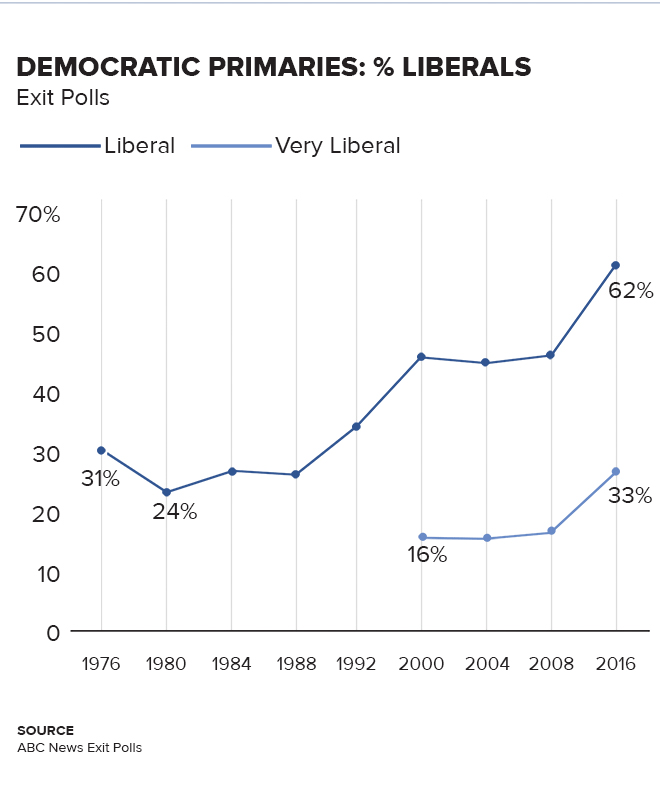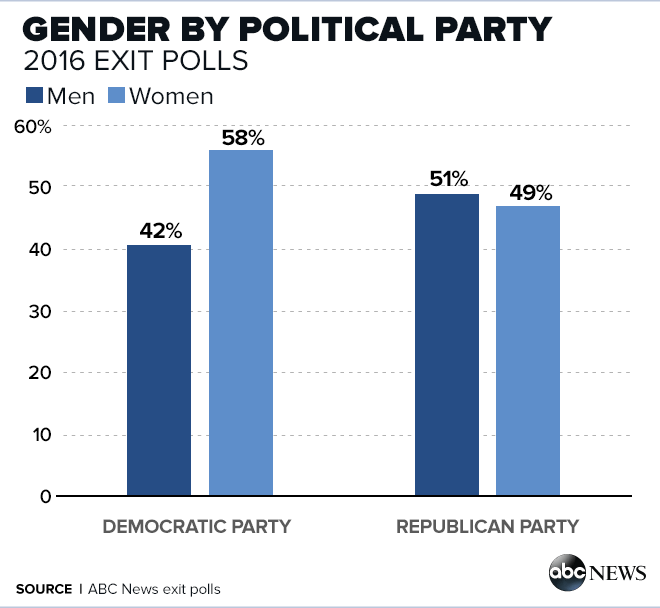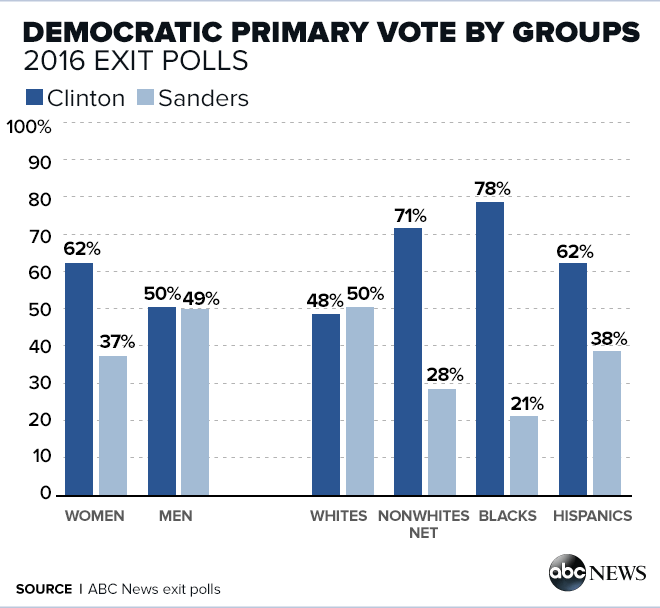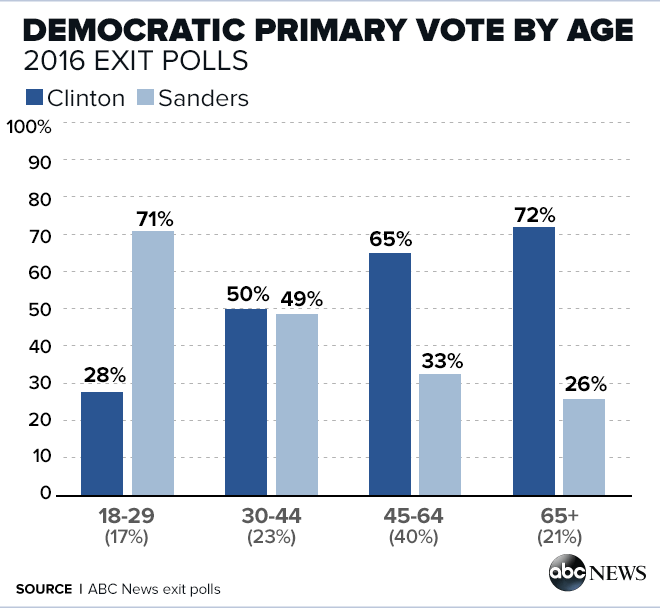Wrapping up a Wild Ride: A 2016 Exit Poll Review (EXIT POLL)
What was that all about?
— -- What was that all about?
"That" is the wild ride of the 2016 primary season, and ABC News exit polls conducted across the primaries provide illuminating answers. For Republicans, it was about demand for an outsider fueled by profound disenchantment with economic and political conditions. For the Democrats, a deep sense of economic unfairness also has played a role -– but without the level of divisiveness that rent the GOP.
As often is the case with election politics, the economy is a good place to start. Unemployment is down to 5.0 percent, below its pre-recession levels –- but economic discontent remains high. Underemployment is one factor -– while also down, it’s nearly double the unemployment number. Long-term unemployment, while also well down, remains high by historical standards.
Perhaps most important is the long-term trend in lagging incomes. Americans with a college degree have seen their real median weekly earnings rise by nearly 23 percent in the past 35 years. All well and good – but those who lack a four-year college degree have seen their real incomes decline by 9 percent. And they account for nearly seven in 10 Americans age 25 and older. Most people, then, feel like they’re doing less well –- because it's true.
That harsh reality played out on both sides of this year's primaries and caucuses for which we have exit poll data. (Note, not all questions reported here were asked in every state.) Forty percent of Democratic voters were "very" worried about the state of the future economy -– a high level of strong worry in its own right -– and that soared to 66 percent among Republican voters. Eighty-four percent of Democratic voters to date have said that the economic system favors the wealthy. A plurality of Democrats –- and notably, a majority of Republican voters -– said they believe trade agreements cost more jobs than they create.
Other factors were at play as well in the exit polls, analyzed this season for ABC News by Langer Research Associates. Consider first some cross-party comparisons:
Ideology
Ideological divisions were sharper than ever, especially given an influx of liberals into the Democratic primaries. Liberals accounted for 24 to 34 percent of Democratic primary voters in exit polls from 1976 to 1992. That rose to 46 or 47 percent in 2000, 2004 and 2008. This year it soared to 62 percent –- a level never before approached. ("Very" liberal voters moved from 16 or 17 percent in recent past cycles to 25 percent in this year's contests.)

The GOP saw a similar trend, if less pronounced. The share of conservatives jumped from the mid-to-high 30s in 1976 and '80 to around six in 10 from 1988 forward, peaking at 67 percent in 2012. This year? Conservatives advanced to 76 percent of primary voters, easily a new high.

One consequence of these trends is that the number of moderates participating in either party's primaries has fallen to new lows. Moderates fell from 54 percent of Democratic primary voters in in 1980 to 32 percent this year. On the Republican side, moderates peaked at 51 percent in 1976. This year -– 22 percent.
Gender and Race/Ethnicity
Even as they matched in ideological polarization, voters in the parallel primaries continued to look far different on other measures. One example: Women accounted for 58 percent of Democratic voters, up 9 points from the 1976 low to match their high. Far fewer GOP primary voters were women, 49 percent, about their typical share.

There's an even starker difference by race and ethnicity. Whites accounted for 90 percent of GOP voters, compared with just 61 percent in the Democratic primaries. Blacks accounted for one in four Democratic voters to date, Hispanics for 9 percent. Both are new highs.
Young voters, 17-29, have reached 17 percent of Democratic primary voters to date, about double their share in 2000 and 2004 and second only to results of 1976 exit polls. They were less numerous in the GOP race, accounting for 11 percent of voters in those contests.
Democratic Groups/Votes
These demographic patterns have played out especially strongly in the Democratic race. Hillary Clinton won women by 62 percent to 37 percent (far better than her 52 percent to 43 percent vs. Barack Obama in 2008) while men divided essentially evenly, 50 percent to 49 percent. The fact that women predominated has been critical for Clinton.
Equally important for Clinton has been the role of nonwhites. They've and backed her by 71 percent to 28 percent, while whites have split about evenly, 50 percent to 48 percent, between Bernie Sanders and Clinton. Clinton has won blacks by 78 percent to 21 percent, Hispanics by 62 percent to 38 percent and Asian-Americans (2 percent of Democratic voters) by 61 percent to 38 percent.

Sanders, for his part, has performed famously well among young voters, winning under-30s by a huge 71 percent to 28 percent, and those younger than 22 even more broadly. A challenge for him is that Clinton's won voters age 65+ by essentially the same margin, 72 percent to 26 percent, and there have been slightly more of them. She's also won 45-64s by 2-1, while she and Sanders have split 30-to-44-year-olds.

Sanders also has run far more closely with Clinton among liberals -– 53 percent to 46 percent, Clinton-Sanders, and 49 percent to 50 percent among very liberals -– than among moderates or the few conservative Democratic voters. With liberals so energized, she has work to do.
Personal attributes have figured prominently in the Democratic race. Sanders has won 73 percent of primary voters chiefly focused on the candidate who's most honest and trustworthy -– a persistent weakness for Clinton -- as well as those looking for the one who "cares about people like me," 56 percent to 42 percent vs. Clinton. Both those results mark potential challenges for Clinton in a general election contest.
That said, by a slight margin, more Democratic voters this cycle have said they cared chiefly about the candidate with the right experience: a tailor-made category for Clinton, who has won 87 percent of their votes. She's also won eight in 10 of the relatively few focused on electability.
Concerns about the economic system have aided Sanders, but less than he might have wished. Clinton has won 72 percent of those who say the economic system is fair to most people; among the vast majority who see the system as unfair, she's done less well -– but still has defeated Sanders in this group, by a 15-point margin, 57 percent to 42 percent. Sanders, too, has labored under a sense among some Democratic voters that his polices aren't realistic –- 38 percent have said so, nearly twice as many as have said the same about Clinton.
Clinton, finally, clearly has benefited among Democratic voters from her association with the Obama administration. A majority across the primaries have said they wanted to see the next president generally continue Barack Obama's policies; 73 percent of them voted for Clinton. Sanders, for his part, has won 67 percent of those looking for more liberal policies -– but they've accounted for only one in three voters in the Democratic primaries.

Republican Groups/Votes
The wild and woolly Republican race, culminating with a reality-TV star billionaire as the party's presumptive nominee, has been a thing unto itself -– dominated not by voting blocs or traditional issues, but rather by Trump's uncanny ability to seize the GOP zeitgeist.
Fifty-two percent of Republican voters this cycle have said they were looking for a political outsider –- nearly four times the number of Democrats who said so, and while not a broad majority, plenty enough for Trump to prevail in a multi-candidate race (especially given the GOP's delegate allocation rules). He won 68 percent of their votes.
That, of course, raises a challenge for Trump: Winning over the four in 10 Republicans who wanted a nominee with political experience. He's won a mere 8 percent in that sizable group.
Similarly, Trump's won 50 percent of GOP voters -– four in 10 of the total -– who describe themselves as angry with the way the federal government is working. He did substantially less well with less-than-angry voters, another group in which he'll need to broaden his appeal.
Strikingly, 68 percent of GOP voters have backed Trump's signature if controversial proposal to temporarily ban non-U.S. Muslims from entering the country; he won 49 percent of their votes, vs. just 19 percent of those who oppose the idea. Many fewer, 41 percent, have signed up for his suggestion to deport all undocumented immigrants – again, though, he won half their votes, as well as three in 10 of those who reject the idea. It’s notable that Trump soared in support in ABC News/Washington Post polls as early as July, as he started enunciating these proposals – and never looked back. Indeed he won particularly strongly – with 54 percent – among GOP primary voters who made their choice more than a month in advance.

Some demographic groups have mattered. Trump, hardly a strong conservative by conventional standards, performed credibly even among very conservative voters, with 36 percent support to Ted Cruz’s 42 percent. That’s been good enough for Trump’s backing from somewhat conservative and moderate voters to seal the deal.
Trump, moreover, ran slightly ahead of Cruz among evangelicals, 38 percent to 34 percent -– 55 percent of the GOP electorate -– and trounced him among non-evangelicals.
Less-educated voters -– those suffering from the declining incomes described above -– were another key group for Trump; he won them by 20 points over Cruz, 47 percent to 27 percent. Trump won college graduates as well, but by a slimmer 9-point margin.
Trump won women voting in the Republican primaries, but by less of a margin over Cruz than he won men -– 37 percent to 27 percent, compared with 45 percent to 26 percent. That shortfall among women is another question surrounding Trump's prospects in the fall.
In the end, the unconventional Trump candidacy has produced a sharply split Republican Party. Fifty-eight percent of GOP voters describe the primaries as "divisive" rather than "energizing" for the party, opposite the view among Democrats. And nearly half of non-Trump voters, 48 percent, have said they won't vote for him for president in November.

That said, Trump has both defied conventional wisdom and seized the potent banner of voter discontent, at least within his party. Clinton, the more conventional candidate, has a more united party but one in which her empathy and trustworthiness are weaker than she'd like. She's also faced with the challenge of appealing to her party's liberals -– the predominant chunk of primary voters -– while also drawing substantial support from moderates, essential in the general election.
Their likely fight ahead should prove epic.